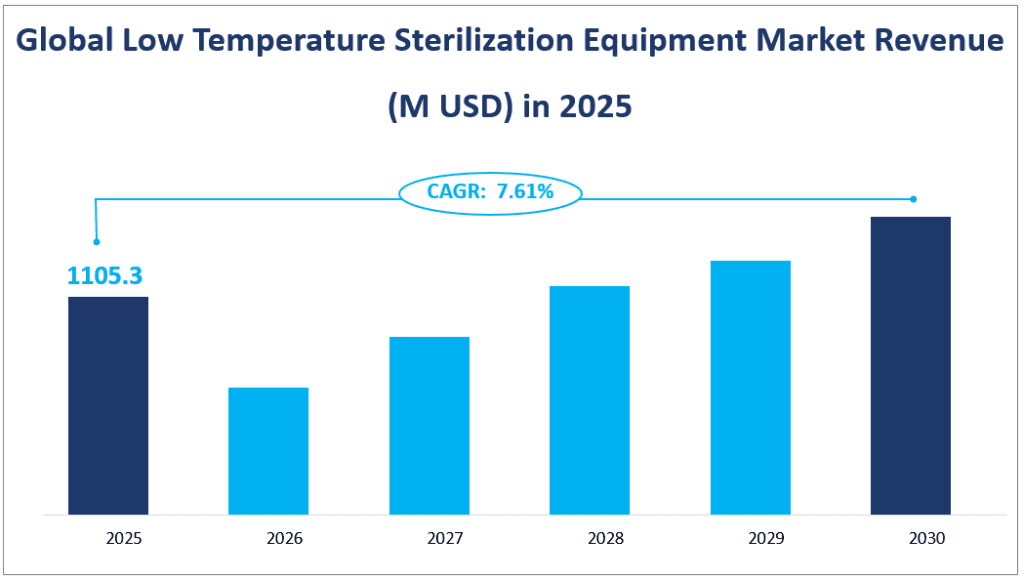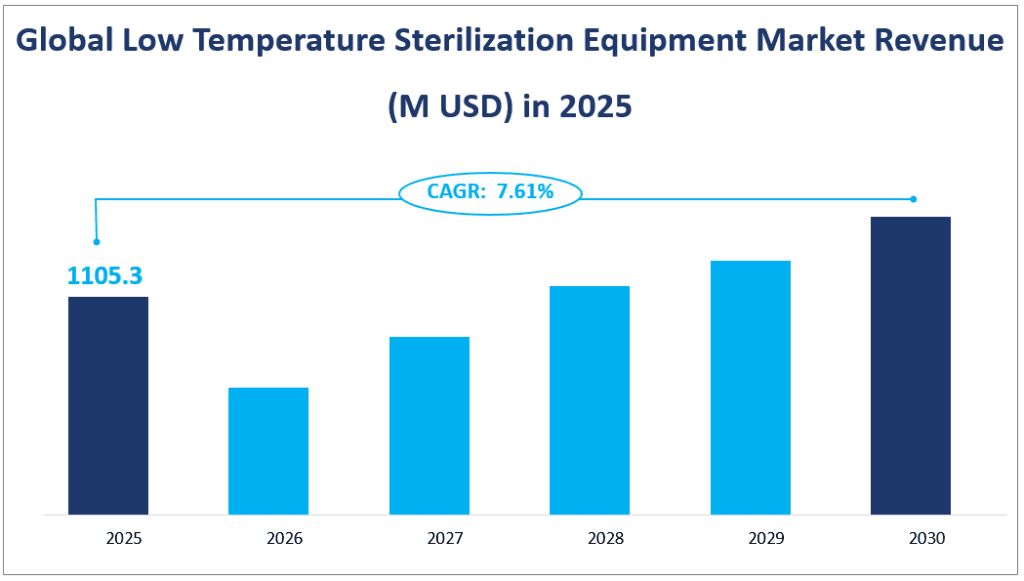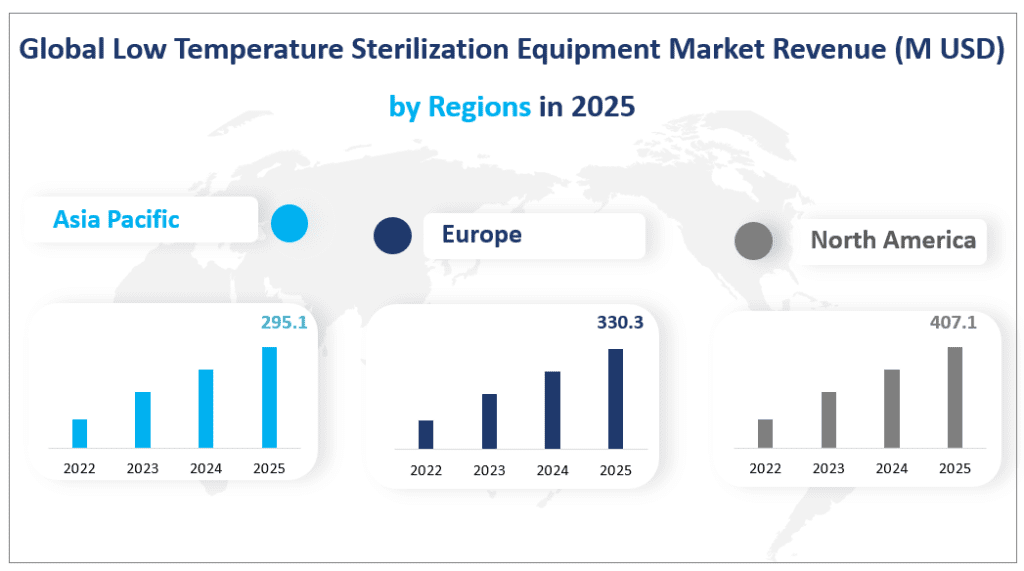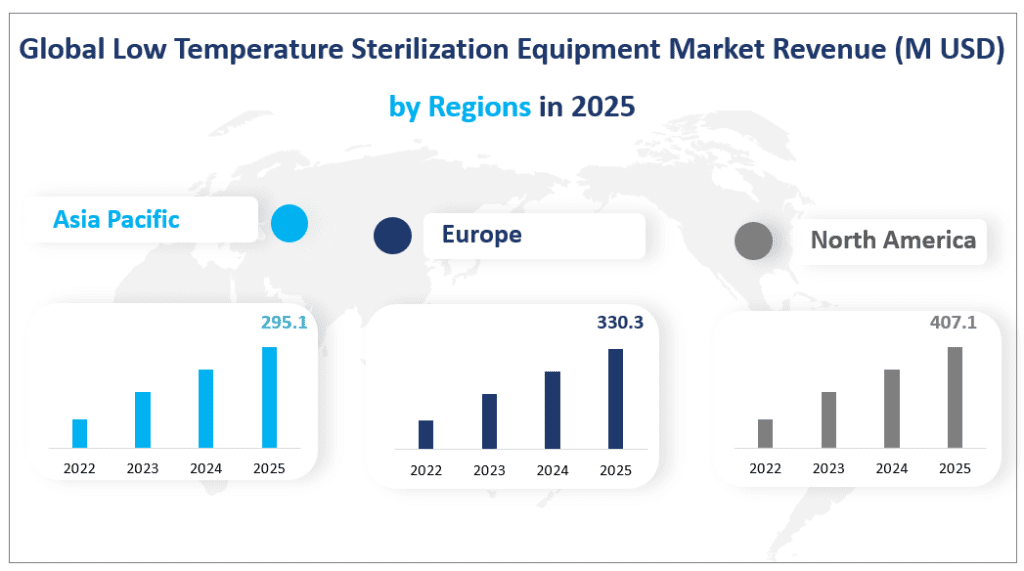1. Global Low-Temperature Sterilization Equipment Market
By 2025, the global low-temperature sterilization equipment market revenue is projected to reach $1,105.3 million with a CAGR of 7.61% from 2025 to 2030.
Low-temperature sterilization equipment refers to devices and technologies designed to sterilize medical instruments and materials at temperatures that are lower than those used in conventional high-temperature sterilization methods. These devices are crucial in healthcare settings, particularly for sterilizing heat-sensitive medical equipment, such as endoscopes, surgical instruments, and other delicate devices.
Global Low-Temperature Sterilization Equipment Market Revenue (M USD) in 2025


2. Driving Factors of Low-Temperature Sterilization Equipment Market
The growth of the global low-temperature sterilization equipment market is driven by several key factors. Firstly, the increasing demand for sterilization in healthcare settings, particularly in hospitals, clinics, ambulatory surgical centers, and pharmaceutical companies, is a major driver.
Another significant factor is the technological advancements in sterilization equipment. Innovations in low-temperature sterilization technologies have led to the development of more efficient, safer, and environmentally friendly devices. For example, vaporized hydrogen peroxide (VHP) systems offer fast cycle times, low temperatures, and environmentally safe by-products, making them highly attractive for use in healthcare facilities. Similarly, advancements in ethylene oxide sterilization have improved its safety and effectiveness, further driving its adoption.
Regulatory support and government initiatives also play a crucial role in the growth of the market. Governments around the world are increasingly focusing on ensuring the safety and efficacy of medical devices, which has led to stricter regulations and guidelines for sterilization processes. This, in turn, has spurred the adoption of advanced low-temperature sterilization equipment to meet these regulatory requirements.
3. Limiting Factors of Low-Temperature Sterilization Equipment Market
Despite the strong growth drivers, the low-temperature sterilization equipment market also faces several challenges and limiting factors. One of the primary concerns is the potential harm associated with certain sterilization agents. For instance, ethylene oxide, while highly effective, is a known carcinogen and poses risks to both healthcare workers and the environment. This has led to increased scrutiny and regulatory restrictions on its use, which can limit market growth.
Another limiting factor is the intense competition within the market. The presence of several established players, such as Advanced Sterilization Products (ASP), Steris, and 3M, has led to a highly competitive environment. This competition can result in price pressures and reduced profit margins for manufacturers. Additionally, the need for specialized technical skills to operate and maintain these advanced sterilization devices can be a barrier to entry for some healthcare facilities, particularly in developing regions.
Lastly, the high costs associated with the purchase and maintenance of low-temperature sterilization equipment can be prohibitive for smaller healthcare providers. The initial investment required for these devices, along with ongoing maintenance and training costs, can be a significant financial burden, limiting the market’s penetration in certain segments.
The global low-temperature sterilization equipment market is set for substantial growth, driven by increasing demand from healthcare facilities, technological advancements, and regulatory support. However, challenges such as the potential harm of certain sterilization agents, intense competition, and high costs must be addressed to ensure sustainable market expansion.
4. Global Low-Temperature Sterilization Equipment Market Segment
Product Types
Among the different product types, Ethylene Oxide Sterilization holds the largest market share. In 2025, it is expected to generate a revenue of $345.5 million, accounting for approximately 31.26% of the total market revenue. Ethylene oxide has long been a staple in the sterilization industry due to its effectiveness in sterilizing heat-sensitive medical devices. Despite concerns about its toxicity, advancements in technology and regulatory oversight have continued to support its widespread use.
The fastest-growing product type is Vaporized Hydrogen Peroxide (VHP). By 2025, VHP is projected to generate a revenue of $357.9 million, with a market share of 32.38% from 2025 to 2030. This growth rate is significantly higher than other product types, driven by its environmental safety, rapid sterilization cycles, and compatibility with a wide range of materials. VHP systems are particularly popular in healthcare settings where quick turnaround times and low-temperature sterilization are critical.
Other notable product types include Steam Sterilization (Dry & Moist), which is expected to reach a revenue of $122.8 million by 2025, and Nitrogen Dioxide (NO2), projected to generate $54.0 million. Both of these technologies offer unique advantages, such as NO2’s ability to sterilize at room temperature and steam sterilization’s reliability and cost-effectiveness.
Market Revenue and Share by Type
| Product Type | Market Revenue (M USD) in 2025 | Market Share in 2025 |
| Vaporized Hydrogen Peroxide (VHP) | 357.9 | 32.38% |
| Nitrogen Dioxide (NO2) | 54.0 | 4.89% |
| Chlorine Dioxide (CLO2) | 21.9 | 1.98% |
| Oxygen | 101.1 | 9.15% |
| Steam Sterilization (Dry & Moist) | 122.8 | 11.11% |
| Supercritical Carbon Dioxide (Scco2) | 19.5 | 1.76% |
| Vaporized Peracetic Acid (VPA) | 15.0 | 1.36% |
| Ethylene Oxide Sterilization | 345.5 | 31.26% |
Market by Applications
Hospitals are the largest consumers of low-temperature sterilization equipment, driven by the need to sterilize a wide range of medical instruments and maintain a sterile environment. In 2025, hospitals are projected to generate a revenue of $391.4 million, accounting for 35.41% of the total market revenue. The growth in this segment is driven by the increasing number of surgical procedures, the need for infection control, and the adoption of advanced sterilization technologies.
Ambulatory Surgical Centers are another significant application area, expected to generate a revenue of $258.1 million by 2025. This segment is growing rapidly, driven by the increasing number of outpatient procedures and the need for efficient and effective sterilization processes.
Pharmaceutical Companies are also a key application area, projected to generate a revenue of $190.1 million by 2025. The growth in this segment is driven by the increasing demand for sterile environments in pharmaceutical production and the need to comply with stringent regulatory standards.
Clinics are another important application area, with a projected revenue of $135.4 million by 2025. The growth in this segment is driven by the increasing number of specialized clinics and the need for effective sterilization processes.
The global low-temperature sterilization equipment market is characterized by a diverse range of product types and applications, each with distinct market dynamics. Ethylene oxide sterilization holds the largest market share, while vaporized hydrogen peroxide (VHP) is the fastest-growing product type. In terms of applications, hospitals dominate the market, followed by ambulatory surgical centers and pharmaceutical companies. The growth in these segments is driven by increasing healthcare demands, regulatory requirements, and technological advancements. As the market continues to evolve, the adoption of advanced sterilization technologies will remain crucial in meeting the growing needs of healthcare facilities worldwide.
Market Revenue and Share by Application
| Application | Market Revenue (M USD) in 2025 | Market Share in 2025 |
| Hospitals | 391.4 | 35.41% |
| Clinics | 135.4 | 12.25% |
| Ambulatory Surgical Centers | 258.1 | 23.35% |
| Pharmaceutical Companies | 190.1 | 17.20% |
5. Regional Low-Temperature Sterilization Equipment Market
Among the major regions, North America is projected to be the largest market by revenue in 2025, with an estimated revenue of $407.1 million. This region’s dominance is attributed to its advanced healthcare infrastructure, stringent regulatory requirements for infection control, and high adoption rates of advanced sterilization technologies.
By 2025, the Asia-Pacific region is expected to generate a revenue of $295.1 million, accounting for 26.70% of the global market. This growth is driven by the increasing prevalence of chronic diseases, the rising demand for non-disposable medical devices, and the growing awareness of hygiene and infection control in emerging economies such as China, India, and Southeast Asia.
Other notable regions include Europe, which is projected to generate a revenue of $330.3 million by 2025, and South America, with an estimated revenue of $42.2 million. Europe’s market growth is supported by its robust healthcare systems and the presence of several key players in the industry. South America, while smaller in size, is also experiencing growth driven by increasing healthcare investments and the adoption of advanced sterilization technologies.
Global Low-Temperature Sterilization Equipment Market Revenue (M USD) by Regions in 2025


6. Top 3 Companies in the Low-Temperature Sterilization Equipment Market
Advanced Sterilization Products (ASP)
Company Introduction and Business Overview: ASP, a subsidiary of Johnson & Johnson, is a leading provider of infection prevention solutions. Established in 1986, ASP is renowned for its innovative and reliable sterilization technologies. The company operates globally and focuses on creating products that enhance patient safety and improve healthcare outcomes.
Products Offered: ASP’s flagship product is the STERRAD® System, which uses vaporized hydrogen peroxide (VHP) for low-temperature sterilization. The STERRAD NX® System with ALLClear® Technology is designed to sterilize a wide range of medical devices, offering fast cycle times and high microbial efficacy.
In 2021, ASP’s revenue from low-temperature sterilization equipment was $162.8 million.
Company Introduction and Business Overview: Steris is a global leader in infection prevention and contamination control solutions. Established in 1985, Steris offers a comprehensive portfolio of products and services designed to improve patient outcomes and enhance operational efficiency in healthcare settings.
Products Offered: Steris provides a variety of low-temperature sterilization technologies, including the VHP 1000i Biodecontamination System and the Finn-Aqua GMP Bio Pharma Sterilizer. These products are designed to meet the stringent requirements of healthcare facilities and pharmaceutical companies.
In 2021, Steris’ revenue from low-temperature sterilization equipment was $114.3 million.
Company Introduction and Business Overview: 3M is a multinational conglomerate known for its innovative and diverse product portfolio. Established in 1902, 3M operates across various industries, including healthcare, where it provides advanced sterilization solutions. The company’s focus on research and development has led to the creation of several groundbreaking technologies.
Products Offered: 3M’s low-temperature sterilization offerings include the 3M™ Steri-Vac™ Sterilizer, which uses ethylene oxide (EO) for effective sterilization of heat-sensitive medical devices. This product is designed to provide reliable and efficient sterilization while minimizing the risk of equipment damage.
In 2021, 3M’s revenue from low-temperature sterilization equipment was $55.6 million.
Major Players
| Company Name | Headquarters | Business Distribution |
| Advanced Sterilization Products (ASP) | USA | Worldwide |
| Steris | USA | Worldwide |
| Belimed | Switzerland | Worldwide |
| 3M | USA | Worldwide |
| Getinge | Sweden | Worldwide |
| Anderson Products | UK | Worldwide |
| MMM Group | Germany | Worldwide |
| Matachana | Spain | Mainly in Europe and Americas |
| Stryker | USA | Worldwide |
| Tuttnauer | Netherlands | Worldwide |
| MedTeco | Russia | Mainly in Europe, Asia, and Latin America |
1 Report Overview
1.1 Study Scope
1.2 Key Market Segments
1.3 Regulatory Scenario by Region/Country
1.4 Market Investment Scenario Strategic
1.5 Market Analysis by Type
1.5.1 Global Low Temperature Sterilization Equipment Market Share by Type (2020-2027)
1.5.2 Vaporized Hydrogen Peroxide (VHP)
1.5.3 Nitrogen Dioxide (NO2)
1.5.4 Chlorine Dioxide (CLO2)
1.5.5 Oxygen
1.5.6 Steam Sterilization (Dry & Moist)
1.5.7 Supercritical Carbon Dioxide (Scco2)
1.5.8 Vaporized Peracetic Acid (VPA)
1.5.9 Ethylene Oxide Sterilization
1.6 Market by Application
1.6.1 Global Low Temperature Sterilization Equipment Market Share by Application (2020-2027)
1.6.2 Hospitals
1.6.3 Clinics
1.6.4 Ambulatory Surgical Centers
1.6.5 Pharmaceutical Companies
1.7 Low Temperature Sterilization Equipment Industry Development Trends under COVID-19 Outbreak
1.7.1 Global COVID-19 Status Overview
1.7.2 Influence of COVID-19 Outbreak on Low Temperature Sterilization Equipment Industry Development
2 Global Growth Trends
2.1 Industry Trends
2.1.1 SWOT Analysis
2.1.2 Porter’s Five Forces Analysis
2.2 Potential Market and Growth Potential Analysis
2.3 Industry News and Policies by Regions
2.3.1 Industry News
2.3.2 Industry Policies
2.4 Industry Trends Under COVID-19
3 Value Chain of Low Temperature Sterilization Equipment Market
3.1 Value Chain Status
3.2 Low Temperature Sterilization Equipment Manufacturing Cost Structure Analysis
3.2.1 Production Process Analysis
3.2.2 Manufacturing Cost Structure of Low Temperature Sterilization Equipment
3.2.3 Labor Cost of Low Temperature Sterilization Equipment
3.3 Sales and Marketing Model Analysis
3.4 Downstream Major Customer Analysis (by Region)
4 Players Profiles
4.1 Advanced Sterilization Products (ASP)
4.1.1 Advanced Sterilization Products (ASP) Basic Information
4.1.2 Low Temperature Sterilization Equipment Product Profiles, Application and Specification
4.1.3 Advanced Sterilization Products (ASP) Low Temperature Sterilization Equipment Market Performance (2016-2021)
4.1.4 Advanced Sterilization Products (ASP) Business Overview
4.2 Steris
4.2.1 Steris Basic Information
4.2.2 Low Temperature Sterilization Equipment Product Profiles, Application and Specification
4.2.3 Steris Low Temperature Sterilization Equipment Market Performance (2016-2021)
4.2.4 Steris Business Overview
4.3 Belimed
4.3.1 Belimed Basic Information
4.3.2 Low Temperature Sterilization Equipment Product Profiles, Application and Specification
4.3.3 Belimed Low Temperature Sterilization Equipment Market Performance (2016-2021)
4.3.4 Belimed Business Overview
4.4 3M
4.4.1 3M Basic Information
4.4.2 Low Temperature Sterilization Equipment Product Profiles, Application and Specification
4.4.3 3M Low Temperature Sterilization Equipment Market Performance (2016-2021)
4.4.4 3M Business Overview
4.5 Getinge
4.5.1 Getinge Basic Information
4.5.2 Low Temperature Sterilization Equipment Product Profiles, Application and Specification
4.5.3 Getinge Low Temperature Sterilization Equipment Market Performance (2016-2021)
4.5.4 Getinge Business Overview
4.6 Anderson Products
4.6.1 Anderson Products Basic Information
4.6.2 Low Temperature Sterilization Equipment Product Profiles, Application and Specification
4.6.3 Anderson Products Low Temperature Sterilization Equipment Market Performance (2016-2021)
4.6.4 Anderson Products Business Overview
4.7 MMM Group
4.7.1 MMM Group Basic Information
4.7.2 Low Temperature Sterilization Equipment Product Profiles, Application and Specification
4.7.3 MMM Group Low Temperature Sterilization Equipment Market Performance (2016-2021)
4.7.4 MMM Group Business Overview
4.8 Matachana
4.8.1 Matachana Basic Information
4.8.2 Low Temperature Sterilization Equipment Product Profiles, Application and Specification
4.8.3 Matachana Low Temperature Sterilization Equipment Market Performance (2016-2021)
4.8.4 Matachana Business Overview
4.9 Stryker
4.9.1 Stryker Basic Information
4.9.2 Low Temperature Sterilization Equipment Product Profiles, Application and Specification
4.9.3 Stryker Low Temperature Sterilization Equipment Market Performance (2016-2021)
4.9.4 Stryker Business Overview
4.10 Tuttnauer
4.10.1 Tuttnauer Basic Information
4.10.2 Low Temperature Sterilization Equipment Product Profiles, Application and Specification
4.10.3 Tuttnauer Low Temperature Sterilization Equipment Market Performance (2016-2021)
4.10.4 Tuttnauer Business Overview
4.11 MedTeco
4.11.1 MedTeco Basic Information
4.11.2 Low Temperature Sterilization Equipment Product Profiles, Application and Specification
4.11.3 MedTeco Low Temperature Sterilization Equipment Market Performance (2016-2021)
4.11.4 MedTeco Business Overview
5 Global Low Temperature Sterilization Equipment Market Analysis by Regions
5.1 Global Low Temperature Sterilization Equipment Sales, Revenue and Market Share by Regions
5.1.1 Global Low Temperature Sterilization Equipment Sales by Regions (2016-2021)
5.1.2 Global Low Temperature Sterilization Equipment Revenue by Regions (2016-2021)
5.2 North America Low Temperature Sterilization Equipment Sales and Growth Rate (2016-2021)
5.3 Europe Low Temperature Sterilization Equipment Sales and Growth Rate (2016-2021)
5.4 Asia-Pacific Low Temperature Sterilization Equipment Sales and Growth Rate (2016-2021)
5.5 Middle East and Africa Low Temperature Sterilization Equipment Sales and Growth Rate (2016-2021)
5.6 South America Low Temperature Sterilization Equipment Sales and Growth Rate (2016-2021)
6 North America Low Temperature Sterilization Equipment Market Analysis by Countries
6.1 North America Low Temperature Sterilization Equipment Sales, Revenue and Market Share by Countries
6.1.1 North America Low Temperature Sterilization Equipment Sales by Countries (2016-2021)
6.1.2 North America Low Temperature Sterilization Equipment Revenue by Countries (2016-2021)
6.1.3 North America Low Temperature Sterilization Equipment Market Under COVID-19
6.2 United States Low Temperature Sterilization Equipment Sales and Growth Rate (2016-2021)
6.2.1 United States Low Temperature Sterilization Equipment Market Under COVID-19
6.3 Canada Low Temperature Sterilization Equipment Sales and Growth Rate (2016-2021)
6.3.1 Canada Low Temperature Sterilization Equipment Market Under COVID-19
6.4 Mexico Low Temperature Sterilization Equipment Sales and Growth Rate (2016-2021)
6.4.1 Mexico Low Temperature Sterilization Equipment Market Under COVID-19
7 Europe Low Temperature Sterilization Equipment Market Analysis by Countries
7.1 Europe Low Temperature Sterilization Equipment Sales, Revenue and Market Share by Countries
7.1.1 Europe Low Temperature Sterilization Equipment Sales by Countries (2016-2021)
7.1.2 Europe Low Temperature Sterilization Equipment Revenue by Countries (2016-2021)
7.1.3 Europe Low Temperature Sterilization Equipment Market Under COVID-19
7.2 Germany Low Temperature Sterilization Equipment Sales and Growth Rate (2016-2021)
7.2.1 Germany Low Temperature Sterilization Equipment Market Under COVID-19
7.3 UK Low Temperature Sterilization Equipment Sales and Growth Rate (2016-2021)
7.3.1 UK Low Temperature Sterilization Equipment Market Under COVID-19
7.4 France Low Temperature Sterilization Equipment Sales and Growth Rate (2016-2021)
7.4.1 France Low Temperature Sterilization Equipment Market Under COVID-19
7.5 Italy Low Temperature Sterilization Equipment Sales and Growth Rate (2016-2021)
7.5.1 Italy Low Temperature Sterilization Equipment Market Under COVID-19
7.6 Spain Low Temperature Sterilization Equipment Sales and Growth Rate (2016-2021)
7.6.1 Spain Low Temperature Sterilization Equipment Market Under COVID-19
7.7 Russia Low Temperature Sterilization Equipment Sales and Growth Rate (2016-2021)
7.7.1 Russia Low Temperature Sterilization Equipment Market Under COVID-19
8 Asia-Pacific Low Temperature Sterilization Equipment Market Analysis by Countries
8.1 Asia-Pacific Low Temperature Sterilization Equipment Sales, Revenue and Market Share by Countries
8.1.1 Asia-Pacific Low Temperature Sterilization Equipment Sales by Countries (2016-2021)
8.1.2 Asia-Pacific Low Temperature Sterilization Equipment Revenue by Countries (2016-2021)
8.1.3 Asia-Pacific Low Temperature Sterilization Equipment Market Under COVID-19
8.2 China Low Temperature Sterilization Equipment Sales and Growth Rate (2016-2021)
8.2.1 China Low Temperature Sterilization Equipment Market Under COVID-19
8.3 Japan Low Temperature Sterilization Equipment Sales and Growth Rate (2016-2021)
8.3.1 Japan Low Temperature Sterilization Equipment Market Under COVID-19
8.4 South Korea Low Temperature Sterilization Equipment Sales and Growth Rate (2016-2021)
8.4.1 South Korea Low Temperature Sterilization Equipment Market Under COVID-19
8.5 Australia Low Temperature Sterilization Equipment Sales and Growth Rate (2016-2021)
8.5.1 Australia Low Temperature Sterilization Equipment Market Under COVID-19
8.6 India Low Temperature Sterilization Equipment Sales and Growth Rate (2016-2021)
8.6.1 India Low Temperature Sterilization Equipment Market Under COVID-19
8.7 Southeast Asia Low Temperature Sterilization Equipment Sales and Growth Rate (2016-2021)
8.7.1 Southeast Asia Low Temperature Sterilization Equipment Market Under COVID-19
9 Middle East and Africa Low Temperature Sterilization Equipment Market Analysis by Countries
9.1 Middle East and Africa Low Temperature Sterilization Equipment Sales, Revenue and Market Share by Countries
9.1.1 Middle East and Africa Low Temperature Sterilization Equipment Sales by Countries (2016-2021)
9.1.2 Middle East and Africa Low Temperature Sterilization Equipment Revenue by Countries (2016-2021)
9.1.3 Middle East and Africa Low Temperature Sterilization Equipment Market Under COVID-19
9.2 Saudi Arabia Low Temperature Sterilization Equipment Sales and Growth Rate (2016-2021)
9.2.1 Saudi Arabia Low Temperature Sterilization Equipment Market Under COVID-19
9.3 UAE Low Temperature Sterilization Equipment Sales and Growth Rate (2016-2021)
9.3.1 UAE Low Temperature Sterilization Equipment Market Under COVID-19
9.4 Egypt Low Temperature Sterilization Equipment Sales and Growth Rate (2016-2021)
9.4.1 Egypt Low Temperature Sterilization Equipment Market Under COVID-19
9.5 Nigeria Low Temperature Sterilization Equipment Sales and Growth Rate (2016-2021)
9.5.1 Nigeria Low Temperature Sterilization Equipment Market Under COVID-19
9.6 South Africa Low Temperature Sterilization Equipment Sales and Growth Rate (2016-2021)
9.6.1 South Africa Low Temperature Sterilization Equipment Market Under COVID-19
10 South America Low Temperature Sterilization Equipment Market Analysis by Countries
10.1 South America Low Temperature Sterilization Equipment Sales, Revenue and Market Share by Countries
10.1.1 South America Low Temperature Sterilization Equipment Sales by Countries (2016-2021)
10.1.2 South America Low Temperature Sterilization Equipment Revenue by Countries (2016-2021)
10.1.3 South America Low Temperature Sterilization Equipment Market Under COVID-19
10.2 Brazil Low Temperature Sterilization Equipment Sales and Growth Rate (2016-2021)
10.2.1 Brazil Low Temperature Sterilization Equipment Market Under COVID-19
10.3 Argentina Low Temperature Sterilization Equipment Sales and Growth Rate (2016-2021)
10.3.1 Argentina Low Temperature Sterilization Equipment Market Under COVID-19
10.4 Colombia Low Temperature Sterilization Equipment Sales and Growth Rate (2016-2021)
10.4.1 Colombia Low Temperature Sterilization Equipment Market Under COVID-19
10.5 Chile Low Temperature Sterilization Equipment Sales and Growth Rate (2016-2021)
10.5.1 Chile Low Temperature Sterilization Equipment Market Under COVID-19
11 Global Low Temperature Sterilization Equipment Market Segment by Types
11.1 Global Low Temperature Sterilization Equipment Revenue and Market Share by Types (2016-2021)
11.2 Vaporized Hydrogen Peroxide (VHP) Revenue and Growth Rate (2016-2021)
11.3 Nitrogen Dioxide (NO2) Revenue and Growth Rate (2016-2021)
11.4 Chlorine Dioxide (CLO2) Revenue and Growth Rate (2016-2021)
11.5 Oxygen Revenue and Growth Rate (2016-2021)
11.6 Steam Sterilization (Dry & Moist) Revenue and Growth Rate (2016-2021)
11.7 Supercritical Carbon Dioxide (Scco2) Revenue and Growth Rate (2016-2021)
11.8 Vaporized Peracetic Acid (VPA) Revenue and Growth Rate (2016-2021)
11.9 Ethylene Oxide Sterilization Revenue and Growth Rate (2016-2021)
12 Global Low Temperature Sterilization Equipment Market Segment by Applications
12.1 Global Low Temperature Sterilization Equipment Sales, Revenue, Market Share by Applications (2016-2021)
12.1.1 Global Low Temperature Sterilization Equipment Sales and Market Share by Applications (2016-2021)
12.1.2 Global Low Temperature Sterilization Equipment Revenue and Market Share by Applications (2016-2021)
12.2 Hospitals Sales, Revenue and Growth Rate (2016-2021)
12.3 Clinics Sales, Revenue and Growth Rate (2016-2021)
12.4 Ambulatory Surgical Centers Sales, Revenue and Growth Rate (2016-2021)
12.5 Pharmaceutical Companies Sales, Revenue and Growth Rate (2016-2021)
13 Low Temperature Sterilization Equipment Market Forecast by Regions (2021-2027)
13.1 Global Low Temperature Sterilization Equipment Sales, Revenue and Growth Rate (2021-2027)
13.2 Low Temperature Sterilization Equipment Market Forecast by Regions (2021-2027)
13.2.1 North America Low Temperature Sterilization Equipment Market Forecast (2021-2027)
13.2.2 Europe Low Temperature Sterilization Equipment Market Forecast (2021-2027)
13.2.3 Asia-Pacific Low Temperature Sterilization Equipment Market Forecast (2021-2027)
13.2.4 Middle East and Africa Low Temperature Sterilization Equipment Market Forecast (2021-2027)
13.2.5 South America Low Temperature Sterilization Equipment Market Forecast (2021-2027)
13.3 Low Temperature Sterilization Equipment Market Forecast by Types (2021-2027)
13.4 Low Temperature Sterilization Equipment Market Forecast by Applications (2021-2027)
13.5 Low Temperature Sterilization Equipment Market Forecast Under COVID-19
14 Appendix
14.1 Methodology
14.2 Research Data Source
14.2.1 Secondary Data
14.2.2 Primary Data
14.2.3 Market Size Estimation
14.2.4 Legal Disclaimer
